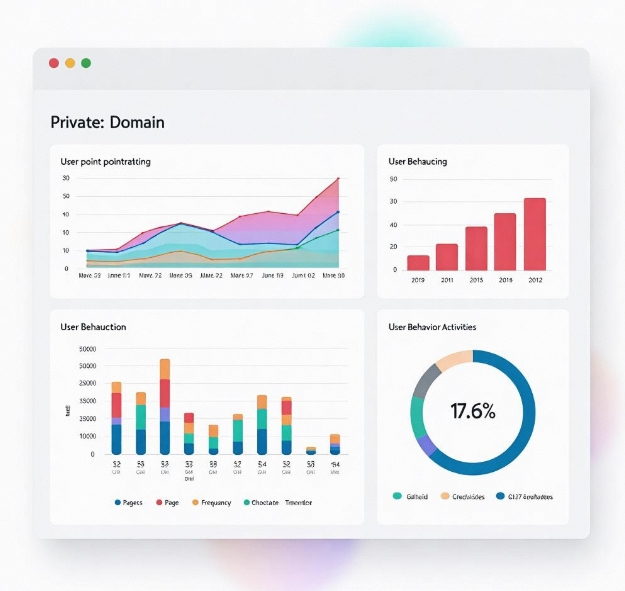How to Build a Brand's Private Domain Traffic Pool Through an Integral Mall?
- latest articles
- 1.DApp Development & Customization: Merging Diverse Market Needs with User Experience 2.Analysis of the Core Technical System in DApp Project Development 3.How to achieve cross-chain interoperability in Web3 projects? 4.How does the tokenization of points reconstruct the e-commerce ecosystem? 5.How to Set and Track Data Metrics for a Points Mall? 6.What is DApp Development? Core Concepts and Technical Analysis 7.Inventory of commonly used Web3 development tools and usage tips 8.Development of a Distribution System Integrated with Social E-commerce 9.Six Key Steps for Businesses to Build a Points Mall System 10.What is DApp Development? A Comprehensive Guide from Concept to Implementation
- Popular Articles
- 1.Future Trends and Technology Predictions for APP Development in 2025 2.Analysis of the DeFi Ecosystem: How Developers Can Participate in Decentralized Finance Innovation 3.From Zero to One: How PI Mall Revolutionizes the Traditional E-commerce Model 4.DAPP Development | Best Practices for Professional Customization and Rapid Launch 5.Recommended by the Web3 developer community: the most noteworthy forums and resources 6.How to Develop a Successful Douyin Mini Program: Technical Architecture and Best Practices 7.From Cloud Computing to Computing Power Leasing: Building a Flexible and Scalable Computing Resource Platform 8.Shared Bike System APP: The Convenient Choice in the Era of Smart Travel 9.How to Create a Successful Dating App: From Needs Analysis to User Experience Design 10.From Design to Development: The Complete Process of Bringing an APP Idea to Life
With the development of the internet and changes in consumption patterns, brands are increasingly focusing on the operation and management of private domain traffic. Private domain traffic refers to user traffic accumulated and managed by brands through their own channels, characterized by high user stickiness and long-term commercial value. Compared to public domain traffic (such as social media, search engine ads, etc.), private domain traffic is a more controllable and low-cost source, making it a focal point for an increasing number of brands. Effectively leveraging private domain traffic to enhance brand value and customer loyalty has become a key factor in brand development.
In this process, points malls, as an effective marketing tool, are playing an increasingly important role. Points malls not only incentivize consumer purchasing behavior but also help brands build a comprehensive private domain traffic pool, bridging the gap between brands and consumers. This article will explore how to create a brand private domain traffic pool through points malls, thereby achieving long-term commercial value for the brand.
I. The Relationship Between Private Domain Traffic and Points Malls
A private domain traffic pool is a long-term and controllable traffic pool formed by brands establishing connections with users through their own channels (such as social media platforms, brand apps, official accounts, etc.). Unlike public domain traffic, private domain traffic is highly interactive and sticky, helping brands build deeper customer relationships. Points malls are one of the key tools to achieve this goal.
A points mall is a reward mechanism provided by brands to consumers, allowing them to accumulate points through purchases, participation in activities, social sharing, etc., and redeem goods or services in the mall. This mechanism not only stimulates consumer purchasing desire but also enhances user engagement and a sense of achievement through point accumulation and redemption, further strengthening the interaction between the brand and consumers.
Through points malls, brands can guide consumers to their own platforms, gradually establishing a private domain traffic pool. The process of consumers spending and redeeming points in the mall is an interactive process between the brand and users, and this interaction promotes the accumulation of the brand's private domain traffic pool.
II. How to Build a Brand Private Domain Traffic Pool Through Points Malls
Define the Goals and Positioning of Private Domain Traffic
Before using points malls to build a private domain traffic pool, brands must first clarify the goals and positioning of private domain traffic. This includes identifying the target user group, the scale of the private domain traffic pool, and how to maximize brand value through traffic accumulation.
For example, for some consumer goods brands, the goal of private domain traffic may be to increase repurchase rates and enhance customer brand loyalty. For some high-end brands, the goal may be to increase customers' single purchase amounts and sales of premium products through precise user operations.
After defining the goals, brands can align the design and operation of the points mall with user needs. For instance, attracting potential customers through personalized point reward mechanisms or enhancing the brand's unique value with exclusive redemption items.
Enhance User Stickiness Through Points Mechanisms
The core of a points mall lies in attracting user participation through reward mechanisms, thereby enhancing user stickiness. By designing reasonable point rules, brands can allow consumers to earn points with every purchase, activity participation, or social sharing, which can then be redeemed for goods or services of varying values in the mall.
For example, brands can incentivize user spending by setting up tiered point reward systems. For instance, offering extra points for reaching a certain spending threshold within a specific period or providing membership point systems based on user purchase frequency to enhance loyalty. These measures encourage consumers to engage with the brand's private domain traffic pool over the long term, effectively boosting user stickiness.
Customize Points Mall Products and Services
To better meet consumer needs, brands can attract more users to the private domain traffic pool by offering customized products and services when building the points mall. By analyzing user behavior and preferences, brands can introduce redemption items that cater to different consumer demands.
For example, brands can launch limited-edition products or exclusive gifts for loyal customers, allowing them to gain unique purchasing experiences through redemption activities in the points mall. Additionally, brands can collaborate with other brands for cross-promotions, offering a wider variety of redemption goods or services to attract more users and increase the appeal of the private domain traffic pool.
Refine Operations to Boost User Engagement
In operating the points mall, brands need to meticulously manage user behavior to enhance engagement. By monitoring and analyzing user behavior, brands can understand consumer interests and habits, enabling them to develop personalized operational strategies.
For instance, brands can tailor point reward plans for different types of consumers based on data such as purchase frequency and amount. Simultaneously, brands can stimulate user participation by regularly hosting redemption events and offering limited-time promotions, thereby increasing the activity level of the private domain traffic pool.
Leverage Social Sharing and Viral Effects to Expand the Traffic Pool
Social marketing is a crucial component in building a private domain traffic pool. The design of the points mall can encourage users to share on social platforms, utilizing word-of-mouth and viral effects to expand the brand's private domain traffic pool.
For example, brands can implement social sharing reward mechanisms in the points mall, encouraging existing users to share activity information with friends. Whenever a new user registers and makes a purchase through an invitation link, both the inviter and the invitee receive point rewards. This viral model not only helps brands rapidly grow their user base but also enhances the conversion rate of new users through trust relationships.
Optimize the Private Domain Traffic Pool Through Data Analysis
Data analysis plays a vital role in operating a private domain traffic pool. Brands can use backend data from the points mall to track user consumption behavior, point redemption patterns, activity levels, etc., in real-time, enabling them to evaluate and optimize the effectiveness of the traffic pool.
For instance, by analyzing users' point accumulation and redemption habits, brands can identify high-value customers and develop personalized marketing strategies for them. Additionally, brands can use data analysis to recognize users at risk of churn and implement retention measures such as promotional activities or coupons in the points mall, thereby improving user retention rates.
III. Case Studies: How Successful Brands Use Points Malls to Build Private Domain Traffic Pools
An E-commerce Platform's Points Mall
An e-commerce platform successfully built a robust private domain traffic pool through its points mall. The platform encouraged consumer spending by implementing point reward mechanisms and enhanced user stickiness through point redemption. Additionally, the platform established different membership tiers, offering varying services and discounts based on users' point levels. This points-based membership system not only increased user activity but also effectively reduced churn, successfully creating a stable private domain traffic pool.
A Sports Brand's Points Mall
A sports brand enhanced user loyalty through its points mall. The brand introduced limited-edition sneakers and exclusive fitness courses as redemption items, attracting a large number of loyal customers. Through precise data analysis, the brand regularly launched redemption items that met consumer demands and expanded the traffic pool via social sharing mechanisms, continuously growing the brand's private domain traffic pool.
IV. Summary
Building a brand private domain traffic pool through points malls not only enhances user engagement and loyalty but also reduces marketing costs and strengthens brand competitiveness. Through refined operations and personalized marketing strategies, brands can attract more consumers into their private domain traffic pools and expand the pool's scale via social marketing. However, to achieve true success, brands must thoroughly understand consumer needs and continuously optimize the operational strategies of their points malls, thereby realizing long-term development and maximizing commercial value.
-

How does the tokenization of points reconstruct the e-commerce ecosystem?
With the continuous advancement of internet technology and the gradual prolifera···
-

How to Set and Track Data Metrics for a Points Mall?
With the rapid development of the e-commerce industry, points malls, as a common···
-

Development of a Distribution System Integrated with Social E-commerce
With the rapid development of internet technology, the e-commerce industry has e···

 Blockchain
Blockchain












